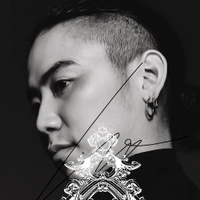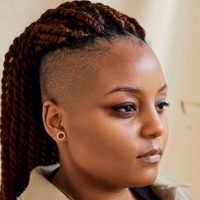On giving yourself space to create
Prelude
Alexandra Levy, better known by her stage name Ada Lea, has released two albums for Omaha’s Saddle Creek Records, 2018’s What We Say in Private, and her most recent second album, 2021’s one hand on the steering wheel the other sewing a garden. Her distinctive storytelling lyrical style paints a picture of not only Levy’s experiences and emotional state, but of her surroundings, as one hand did so evocatively of her hometown of Montreal. A painter as well as a musician, Levy is capable of telling a story via multiple mediums.
Conversation
On giving yourself space to create
Musician Ada Lea discusses keeping the creative process dynamic.
As told to Emma Bowers, 1866 words.
Tags: Music, Art, Inspiration, Success, Failure, Process.
You wrote a lot of your last record in Banff but you live primarily in Montreal. How did this new environment affect your creative process?
A lot of the songs were Banff songs, but a handful were written before then. Early in the pandemic, I found a cabin to rent, and was like, “Oh, this is a perfect opportunity to leave the home and move to the country.” I’d come back to the city every few weeks and notice my anxiety and overall view of life become dark, by feeling overwhelmed by obligations. There is something about being in nature where I don’t have to pretend to be something I’m not, and I can just create at my own pace. I feel most connected to myself and others when there’s that silence. I seem to have a really hard time finding it in the city.
Since you know this about yourself now, how do you find ways to get yourself in that space more often?
I don’t think I could have finished the album if I had stayed in the city; that’s where I got everything done. Waking up to birds rather than airplanes flying over my head, you don’t realize until you’re away from the city, how intrusive it is being around the noise. I am looking for more places to rent, and to hopefully move to the country one day. I would love to be able to do that.
There’s often this extended sense of time outside of cities, and time is such a valuable resource when it comes to creativity. In thinking of time as a resource, how has the unfolding of your career has felt, the pace of it? Have you been able to take things at your own pace and find a sense of control?
I definitely don’t feel I have control over it, but I do see the larger patterns. There’s the frenzy of creating, then there needs to be the down time of integrating. I think that’s the hardest thing to do: to step back, assimilate and integrate. I’m not always willing to admit when I’ve reached that phase because it feels like giving up, as if what I’m actually thinking is “Oh, the things I’ve been creating suck and I guess I should be assimilating.”
Do you feel like that comes from a sense of pressure when it comes to being productive?
I was listening to a George Saunders interview where he was saying that in his younger years, he’d write off an entire day of creativity if something came up and he couldn’t dedicate a block of four or six hours to writing. Then he realized, “Oh, actually, I’m really only looking for these 20 minutes of time, because those minutes add up.” I really do believe in that approach, because you can take 20 minutes anywhere really, even on tour. I’ve somehow written while traveling, even when I don’t have those huge blocks of time I think I need in order to create something meaningful. You can’t really do anything interesting when you’re exhausted and when your mental health isn’t great.
Mental health is such a massive part of an artists’ capacity to be creative. How did trying to maintain your mental wellness play into the work of making a record?
2019 was particularly difficult. Towards the end of that year, when I was in Europe and writing the rest of the album, those were some of the darkest moments. I know that came with the stress of touring and the financial anxieties around that.
I’m surprised that I managed to write stuff in Banff. I knew I’d be recording in early February with Marshall (Vore), so I thought “I need more songs, I just need to do this.” For the three weeks at Banff, I approached it like some sort of game where I was trying different sleep schedules out, and had a goal of writing a song a day, and then recording it either that day or the next.
That’s really interesting. The sleeping schedules, you were waking up in the middle of the night trying to write songs?
There was one method I was trying where I wouldn’t have a full night’s sleep; I would just take naps and try working at random times and intervals. I read somewhere that it could be helpful, so I thought I’d try it.
How do you feel like that shows up in what you made during that period?
“Can’t Stop Me From Dying” was written in that way, and I thought, “This is the weirdest thing.” I shared it with some of my close friends asking “Is this a funny song or this cool? Is this horrible?” and they were like, “You should finish it. Why not?” I don’t think anyone really understood what was happening for me, emotionally. There was another song that came out at that time, “Hurt.” It feels like a weird time to try and remember because it really felt foggy even when I was living it.
In addition to your music, you’re a painter and you’ve dabbled in poetry, how do all these practices coexist in your daily life?
I’d love to talk about my idea of the perfect creative day, which would start with waking up between 5:00 and 6:00am, having coffee and writing. I found The Artist’s Way cringey in many ways, but there was one thing I took away from it, which was the morning pages. I’ve grown used to writing them every morning, so those three pages are where I work through issues happening on an interpersonal level. Then I’ll try and work through some of my more vague creative ideas and logistical things, then I can get on with my day. Ideally, reading would happen after that. Then from 7:30 to 9:00am, I would work on a song or a demo. I would make my way to my painting studio at 11:00am, and this is where I’d try working in blocks. A big time block for painting, a block for drawing and then writing. The Holy Trinity of : painting/drawing, writing, and song. If I can hit all of those in one day, then I’m in a great mood. It’s taken me 12 years trying to figure out the perfect routine, the perfect day.
Do those different creative practices overlap or talk to each other?
I don’t think they do. I’m taking classes at Concordia University: a painting class, a drawing class, and I’m auditing a course on New American poetry. It’s easy to separate everything, because the projects don’t look the same, and with these different projects I’m not after the same things.
In drawing we just finished a “myth makers” project where we had to create an origin story. My idea was to do the origin story of the moon; that the moon started off as an orange that fell down the stairs, got bruised up and moldy, and when it rolled out into the garden all of the other wildlife and flowers thought it just looked so ugly that they decided the orange didn’t belong there with them. The grass created a slingshot and propelled the orange into the sky. And when they saw the orange from afar, they were like, “Wow, this is the most beautiful thing we’ve ever seen!” They immediately regretted sending it up, but it was too late. So yesterday for instance, I spent a block working on drawings for that specific project. For my painting class we’re working on family portraits. There are specific readings for my poetry class.
With more general writing there’s this method that I’ve been using, similar to my Banff method of writing a song a day and then recording it. I came up with it with a friend and we call it The Method. I would like to develop some sort of book or how-to guide.
This friend wanted to try the literary version of The Method, where every three days a short story is due. I’d never written short stories before, so I saw it as a good challenge. We’re doing The Literary Method now.
It sounds like working in this dynamic way helps to keep the creative channel really open, and it might help to keep it, not impersonal, but keep it light. A way of helping it to feel like not everything you make has to be a referendum on whether or not you’re some great artist, and not everything has to be released.
That’s it 100%. I think failure comes from being too fixated on the finished product, and so creative success must be the focus on the process. Fixation on the product blocks you because you’re thinking, “Well, there are all of these other things that I have to get better at before I can actually do something that will be good.” And then you are overwhelmed.
For me personally, if I’m approaching it from the place of “I have all of these things I want to learn and I’m just working through it very slowly,” the finished piece really doesn’t matter. I just really want to get better at writing a song, writing a story, and painting. I just need to trust that doing it is what matters most. I’m definitely not going to get better by focusing on the preciousness of the final thing and laboring over it. You don’t need to release everything you make, but there should be more emphasis on the process than the final creation.
You give a lot of different things the opportunity to breathe, and then whatever wants to rise to the top, that’s there, then there’s also a ton of stuff in the middle and maybe on the bottom for other people to find. What’s your take on technical skills?
I love talking about the importance of developing technical skills. It’s also interesting at the school I’m at now. The art program is so different from the music program that I went to at The New School where the emphasis was on theory, ear training and instrument proficiency. It was a program designed to get the students to a level where their instrument wouldn’t be much of an obstacle for expression.
There’s no structure regarding technique in the art program I’m in now. And I’m thinking, “I’m here because I want to learn about the techniques, teach me the skills!” And the teacher says, “We can’t teach someone creativity.” I’ve gotten into some arguments, like, “Yeah, of course you can’t teach creativity, but you can teach us the skills and the techniques that we can then use to be creative.” Without those skills and techniques, I don’t even know what the process would look like.
I really do see the value in the techniques and developing a skill set.
Ada Lea Recommends:
Works by the author Rachel Cusk
The Matrix: Poems 1960-1970 by N.H. Pritchard
The Dialectical Behavior Skills Workbook by Matthew McKay, Jeffrey Wood and Jeffrey Brantley
Walking for 25 minutes
“The Method” as described above
- Name
- Ada Lea
- Vocation
- musician and visual artist
Some Things
Pagination



